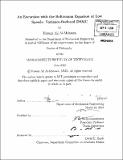An excursion with the Boltzmann equation at low speeds : variance-reduced DSMC
Author(s)
Al-Mohssen, Husain Ali, 1977-
DownloadFull printable version (11.79Mb)
Other Contributors
Massachusetts Institute of Technology. Dept. of Mechanical Engineering.
Advisor
N. G. Hadjiconstantinou.
Terms of use
Metadata
Show full item recordAbstract
The goal of the present thesis is to develop a practical method for simulating low-signal kinetic (small-scale) gaseous flows. These flows have recently received renewed attention in connection with the design and optimization of MEMS/NEMS devices operating in gaseous environments; they are typically described using the Boltzmann equation which is most efficiently solved using a stochastic particle simulation method known as direct simulation Monte Carlo (DSMC). The latter is a simple and versatile simulation method which is very efficient in producing samples of the single particle distribution function which can be used for estimating hydrodynamic properties. Unfortunately, in cases where the signal of interest is small (e.g. low-speed flows), the computational cost associated with reducing the statistical uncertainty of simulation outputs becomes overwhelming. This thesis presents a variance reduction approach for reducing the statistical uncertainty associated with low-signal flows thus making their simulation not only possible but also efficient. Variance reduction is achieved using a control variate approach based on the observation that low-signal flows are typically close to an equilibrium state. As with previous variance reduction methods, significant variance reduction is achieved making the simulation of arbitrarily small deviations from equilibrium possible. However, in contrast to previous variance-reduction methods, the method proposed, which we will refer to as VRDSMC, is able to reduce the variance with virtually no modification to the standard DSMC algorithm. This is achieved by introducing an auxiliary equilibrium simulation which, via an importance weight formulation, uses the same particle data as the non-equilibrium (DSMC) calculation; subtracting the equilibrium from the non-equilibrium hydrodynamic fields drastically reduces the statistical uncertainty of the latter because the two fields are correlated. By retaining the basic DSMC formulation, in contrast to previous approaches, the VRDSMC approach combines ease of implementation with computational efficiency and the ability to simulate all molecular interaction models available within the DSMC formulation. Our validation tests show that the proposed VRDSMC method provides considerable variance reduction for only a small increase in computational cost and approximation error compared to equivalent DSMC simulations. In other words, by addressing the major weakness associated with DSMC, VRDSMC is well suited to the solution of low-signal kinetic problems of practical interest.
Description
Thesis (Ph. D.)--Massachusetts Institute of Technology, Dept. of Mechanical Engineering, 2010. Cataloged from PDF version of thesis. Includes bibliographical references (p. 133-139).
Date issued
2010Department
Massachusetts Institute of Technology. Department of Mechanical EngineeringPublisher
Massachusetts Institute of Technology
Keywords
Mechanical Engineering.